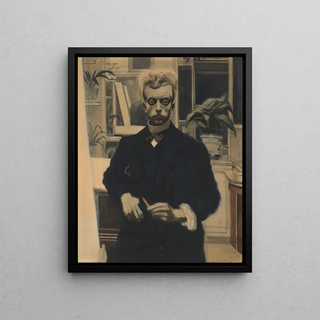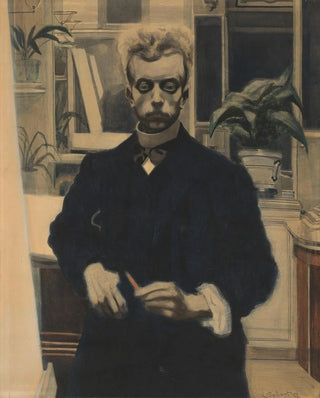Art print | Red pencil self-portrait - Léon Spilliaert


View from behind

Frame (optional)
Léon Spilliaert's Red Pencil Self-Portrait is a work that transcends mere lines of drawing to immerse the viewer in the artist's intimacy. Created in 1907, this iconic piece bears witness to profound introspection and a quest for identity that characterizes Spilliaert's work. The red pencil, the chosen instrument, allows the artist to play with shades and shadows, revealing a complex and troubled personality. This portrait is not just a physical representation but a psychological exploration that invites silent and emotional contemplation.
**Style and uniqueness of the work**
Spilliaert's style is distinguished by bold use of color and shapes, but it is in this self-portrait that one perceives the very essence of his art. The line is both precise and fluid, creating a movement that seems to capture the artist's soul. The slightly turned face expresses palpable melancholy, accentuated by delicate shadows that highlight the features. The presence of the red pencil adds an almost tactile dimension to the piece, evoking warmth and emotional intensity. This choice of medium, far from being trivial, contributes to the introspective atmosphere and the psychological depth emanating from this creation. In sum, the Red Pencil Self-Portrait is a masterful piece that illustrates art's ability to transcend the visible to touch the invisible.
**The artist and his influence**
Léon Spilliaert, born in 1881 in Ostend, is often associated with the symbolist movement, but his work goes far beyond simple classifications. Influenced by the maritime atmosphere of his hometown, he explores themes such as solitude, introspection, and mystery. His unique style, blending expressionism and surrealism, paved the way for many contemporary artists. The Red Pencil Self-Portrait embodies this quest for self, a reflection of the soul of a man tormented by his own demons. Through his works, Spilliaert captured the essence of human existence, making his vision universal and timeless.

Matte finish

View from behind

Frame (optional)
Léon Spilliaert's Red Pencil Self-Portrait is a work that transcends mere lines of drawing to immerse the viewer in the artist's intimacy. Created in 1907, this iconic piece bears witness to profound introspection and a quest for identity that characterizes Spilliaert's work. The red pencil, the chosen instrument, allows the artist to play with shades and shadows, revealing a complex and troubled personality. This portrait is not just a physical representation but a psychological exploration that invites silent and emotional contemplation.
**Style and uniqueness of the work**
Spilliaert's style is distinguished by bold use of color and shapes, but it is in this self-portrait that one perceives the very essence of his art. The line is both precise and fluid, creating a movement that seems to capture the artist's soul. The slightly turned face expresses palpable melancholy, accentuated by delicate shadows that highlight the features. The presence of the red pencil adds an almost tactile dimension to the piece, evoking warmth and emotional intensity. This choice of medium, far from being trivial, contributes to the introspective atmosphere and the psychological depth emanating from this creation. In sum, the Red Pencil Self-Portrait is a masterful piece that illustrates art's ability to transcend the visible to touch the invisible.
**The artist and his influence**
Léon Spilliaert, born in 1881 in Ostend, is often associated with the symbolist movement, but his work goes far beyond simple classifications. Influenced by the maritime atmosphere of his hometown, he explores themes such as solitude, introspection, and mystery. His unique style, blending expressionism and surrealism, paved the way for many contemporary artists. The Red Pencil Self-Portrait embodies this quest for self, a reflection of the soul of a man tormented by his own demons. Through his works, Spilliaert captured the essence of human existence, making his vision universal and timeless.






